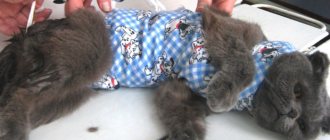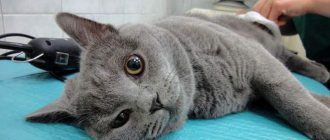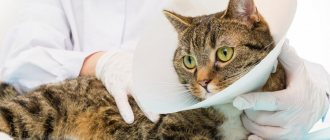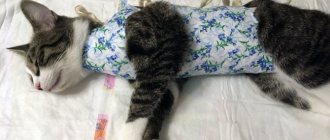9683Administration
Castration is an operation during which the testes are removed from cats, after which the animal does not experience sexual attraction to females. Castration is carried out under anesthesia, and animal owners are interested in the question: “How long does it take a cat to recover from anesthesia after castration?”
Even a veterinarian cannot give an unambiguous, accurate answer to this question, because it depends on the age and individual characteristics of his body. The older he is, the longer it will take to recover from anesthesia, so it is advisable to castrate your pet at a young age.
On average, a cat recovers from anesthesia after castration from 2 to 12 hours.
Young and active animals begin to try to stand up and crawl within a couple of hours, while calmer pets can lie motionless for several hours. With the correct calculation of the drug for the animal, the pet will recover from anesthesia in 2-8 hours, but if it does not try to move for more than 8 hours, it is necessary to consult the doctor who performed the castration. For cats, they do not use ordinary anesthesia, but special drugs, under the influence of which their sensitivity is reduced, but their eyes remain open.
© shutterstock
How long does it take for a cat to recover from anesthesia?
The operation is performed in a clinic or at home. The animal's behavior seems strange in the first 5 or 6 hours after anesthesia. You can't leave him alone. At this time, the anesthetic effect ends and the animal’s postoperative sutures begin to hurt.
Urinary incontinence occurs, but this phenomenon is temporary and passes quickly. The pet's behavior returns to normal within one or two days. The exact time of residual effect of narcotic substances depends on the type of anesthesia, age and other individual characteristics of the animal. During this period, the pet needs the care of the owner.
Positive aspects of the operation
Those owners of domestic cats who have finally decided to neuter their pet often ask whether there are any positive aspects to this operation. In fact, there are quite a few of them:
- the cat stops marking its territory (in some animals this function does not completely disappear, but marks appear much less frequently, and their smell becomes less pungent);
- cat “concerts” are stopped;
- the animal becomes calmer, aggression disappears;
- friendly relations are established between him and other animals in the house;
- the cat, having lost interest in the opposite sex, becomes more attached to the owner and plays with children with great pleasure.
Obesity, which so often accompanies castration, is not at all inevitable. This is not a complication or a consequence of the operation, but just errors in nutrition - by the way, easily eliminated.
In order for your pet to remain in excellent shape after castration, do not neglect the advice of veterinarians: fewer calories and more exercise. Health to you and your pets!
How cats recover from anesthesia after castration - features of the condition
The process of recovery from anesthesia is individual. Some pets behave aggressively, others wake up slowly and remain lethargic for a long time. An inexperienced pet owner runs the risk of being bitten or scratched.
The side effect of drugs is prolonged disorientation in space and impaired coordination of movements. To prevent the consequences of physical activity, the cat is placed in a place from which it cannot fall. The best option is to leave it in a carrier for a while, in a warm, dry place without drafts and away from heating radiators.
Be sure to read:
A cat has a lump on her stomach after sterilization: reasons for the appearance of ours and under the suture, what to do, prevention
When to call a doctor
Most often, a cat feels satisfactory after anesthesia. Side effects do occur, but most often they are short-term. However, there are a number of signs, if they persist, you should urgently take your pet to the veterinarian:
- pallor, blueness, redness of mucous membranes;
- irregular heart rhythm, weak, twitching pulse;
- temperature disturbance, lack of reaction to touch;
- you see that your pet is feeling unwell, this can be reflected in everything.
Contact your veterinarian, even if it's midnight. After all, anesthesia seriously strains the pet’s heart and respiratory organs. Timely help is sometimes the only chance to save a cat’s life.
How to behave when a cat recovers from anesthesia, what to do?
The first three days of the pet should not be lost sight of. You need to monitor the healing process and do not let the cat lick the wound. Otherwise, infection and purulent inflammation are possible. To prevent licking, wear an Elizabethan collar. The seams are treated with products recommended by the veterinarian. If the cat quickly came to his senses, the wounds do not bother him, and they should not be treated again.
Clean water should be nearby at all times. If the animal wants to drink, but cannot do it, you need to wet the mouth with a syringe or pipette, but do not inject it forcibly. You cannot feed your pet on the first day.
An empty tray without filler is placed next to the convalescent person so that the animal does not clog the wound. The toilet should be cleaned daily, or even better after each visit. If the first bowel movements do not occur in the tray, there is no need to punish. It may be painful for a cat to climb. When the condition returns to normal, the habit of going to the toilet will be restored.
If a cat is soiled with urine, it should not be bathed. You should use refreshing wipes.
Ideal age for castration of cats
Castration of cats can be carried out at any age and at any time of the year, but in the summer it is better not to do it. In the heat, there is a risk of poor healing of a surgical wound due to increased proliferation of opportunistic microflora.
It should also be taken into account that furry males most easily tolerate castration at the age of 6-7 months; in a more mature state of the body, the risk of postoperative complications increases significantly.
- The most common complication is bleeding (drip, moderate and heavy).
- In more rare cases, prolapse of intestinal loops, sepsis, or blood poisoning may occur.
Cat after anesthesia: 6 signs that should alert the owner
A conscientious owner takes a vacation while caring for a neutered cat. Despite the simplicity of the operation, your pet may experience complications for a number of reasons.
The following are symptoms that may require veterinary attention:
- Low or high body temperature. The norm for cats is from 37.5 to 39.0 °C. The veterinary surgeon who performed the operation will tell you how often you need to measure your temperature. The problem is that anal measurement is painful. Therefore, purchase an ear or non-contact thermometer. The costs will pay off, since the need for thermometry will arise more than once during your life.
- Refusal to drink for a day and food for more than three days. If the cat does not drink, the concentration of salts in the urine will increase, which can lead to sedimentation and the onset of urolithiasis. Some cats may go 3 or more days without drinking when fed wet, prepared, canned food or natural food. But after the operation, a day is considered an acceptable period. Perhaps refusal to drink indicates intoxication, in which vomiting occurs when food or water enters the stomach. A healthy cat can go without food for 5 days. But, for the speedy healing of wounds, the operated pet needs nutrients. On the second day, a third of the feed is given from the norm, and at the end of the week the consumption is brought up to the recommended value.
- Stiffness in movements due to a feeling of interference in the perineum. This may be due to swelling of the sutures, but it is dangerous to act at your own risk.
- Pain when stroking the abdomen. Probably, the infection entered the abdominal cavity during the operation, or after it with a sudden movement, peritonitis develops
- Painful and difficult urination , accompanied by a plaintive meow.
- Dehiscence of the suture, bleeding for 2-3 days or the appearance of purulent discharge.
Be sure to read:
When can you bathe a cat after castration: what is it for, what products to use, how to wash
What kind of anesthesia is given?
Castration of a cat is considered one of the simplest surgical interventions in veterinary practice. Mostly veterinarians resort to weak anesthesia. A medication is used that reduces the sensitivity of the pet for a certain period. It often takes 10 to 30 minutes for a cat to fall asleep quickly after administering the medicine. This time is directly related to the individual characteristics of a particular cat. The dosage of the medication is calculated by the veterinarian depending on the kitten’s body weight and age. According to data, animals that have a red coat are more resistant to anesthesia than cats with a different coat color, so they are often given a larger dose of pharmaceuticals.
How long can a cat have a fever after castration?
After castration, as after any surgical intervention, it is necessary to monitor body temperature. In the first hours it may drop below 37 °C. This is explained by stress, blood loss, and slowing of metabolism under the influence of anesthesia. The cat may shiver, so it should be well wrapped.
The advice to cover your pet with heating pads is questionable, as it promotes bleeding. The temperature should return to normal within 24 hours. If hypothermia continues for the second day, you should inform your veterinarian.
But, on the first day the temperature can rise to 40 °C. If no other pathological symptoms are noticed, there is no need to worry. But when a pet has a fever 4 or more days after surgery, veterinary care is necessary: an inflammatory process develops. You should not give your cat antipyretic medications, since their effect on humans and cats is different.
How long does the operation take?
As a rule, castration of a cat takes place very quickly: literally in 10-20 minutes. It takes much more time to prepare for it. During the operation, the testes responsible for the production of sex hormones are removed. The veterinarian makes thin incisions through which he removes them. If the pet owner is present for the operation, the doctor may show the extracted testes to prove that the operation was successful.
Many cat owners feel remorse because they have deprived their pet of its privacy, made it inferior, and practically an undercat. It would be a huge mistake to think so. Castration deprives the cat of interest in the tailed representatives of the fair sex and the possibility of reproduction - but that’s all!
Think about how many uncastrated cats die under the wheels of cars and in the teeth of stray dogs, how many fall from balconies and loggias when, obeying the call of ancient instinct, they go in search of a partner! Painful death or serious injury – would you really want such a fate for your pet? Of course not. So put all your regrets aside and give your pet maximum attention while he recovers from surgery. By doing this, you will further strengthen his affection for you, and you yourself will be able to atone for your completely groundless guilt before him for the damage caused - and, by the way, greatly exaggerated! – suffering.
Dangerous consequences
An animal should definitely be taken to the vet if it produces blood when trying to urinate.
It is important for the owner to monitor the condition of the animal. The following conditions are considered unsafe:
- a serious increase or decrease in body temperature;
- change in heart rhythm;
- immobility for more than 12 hours after surgery;
- lack of pupillary reaction to light;
- severe vomiting that lasts more than 24 hours;
- constipation for 3 days;
- pain during bowel movements;
- presence of blood impurities in urine;
- discharge of pus from wounds.
Difference between sedation and anesthesia in cats
Many people confuse sedation with anesthesia. Although they are related, they refer to different stages of sensory loss. These:
- Local anesthesia : sensation is lost only in a specific part of the body, but otherwise the animal remains conscious.
- Sedation : This is when a cat's central nervous system is suppressed, preventing the animal from feeling pain without losing consciousness.
- General anesthesia : suppress the central nervous system to such an extent that the cat feels no sensation and becomes completely unconscious.
© shutterstock
The type of anesthesia your cat will receive depends on the type of surgery. If the surgery is invasive, general anesthesia will likely be required. However, this will be determined by the veterinarian during the pre-anesthesia examination. This is an assessment to understand the cat's clinical picture and overall health. They will check:
- Complete medical history (existing diseases and medications)
- Physical examination (vital signs, mucous membranes, capillary refill time and body condition)
- Blood test and biochemistry
- Analysis of urine
- Electrocardiogram to assess heart condition
- In some cases, x-ray or ultrasound
Surgery in adulthood
If late castration is performed - after the age of 2-3 years, in this case the behavior and habits of the animal are entrenched, coping with them can be difficult, and sometimes impossible. In addition, after late intervention, the risk of developing obesity and the appearance of urolithiasis in the animal is extremely high.
Thus, veterinarians believe that both early and late neutering are not very desirable. The ideal period for the operation is considered to be from 6 months to one year. At this time, sex hormones have not yet greatly influenced the development of the male, and the condition of the organs is ideal for intervention.
Veterinarians advise British cats to be neutered at the age of at least eight months. Persian - upon reaching one year. This is due to the later sexual development of these breeds. If they undergo surgery at an earlier age, the likelihood of negative consequences increases.
Sterilization and post-operative care of a cat
Sterilization (castration) operation – if you decide to have a sterilization operation for your pet, we suggest that you familiarize yourself with the recommendations for caring for your cat after the operation, because the postoperative period is the most important, and it falls on your shoulders. After the operation, the veterinarian must tell you about all the intricacies of caring for the animal after anesthesia.
Read: Sterilizing a cat
Here is a list of our recommendations that will definitely be useful to you.
What is it and how is it done?
Before considering how cats tolerate castration and other nuances of the intervention, we should dwell on the definition and types of manipulation.
During the procedure, the male’s testes are not simply removed, as is commonly thought, but the animal’s sexual function is also stopped, so different methods are used:
- Surgical method - performed through surgery. During it, the doctor opens the animal’s scrotum, removes the testes and ligates the canals.
- Medical sterilization. An implant is sewn under the animal’s skin, releasing drugs that suppress sexual instincts. The procedure is expensive, but is considered the safest.
- Chemical castration. In this case, substances are introduced into the testes that kill glandular tissue, which is subsequently replaced by connective tissue.
- Radiation sterility. In this case, the testes are placed under a source of gamma radiation. The method is quite simple, but the appropriate equipment is rarely found in clinics.
So, not every case requires a scalpel. The available choice of methods allows you to sterilize even old pets without risking their health and life. The veterinarian decides which castration is best for a cat, taking into account the age, health status of the animal and the capabilities available at the clinic.
In our country, they most often resort to the classical method of surgery. The reasons for this are the simplicity and cost-effectiveness of the technique. Let's dwell on it in more detail.
Abnormal stool
After surgery, the cat's intestinal function may be disrupted and constipation or diarrhea may appear, which is accompanied by pain and brings additional suffering to the animal. You need to pay attention to the following signs:
- refusal to eat;
- plaintive meow;
- absence of acts of defecation;
- periodically appearing trembling of the back of the body.
If your cat is constipated, you need to purchase a laxative for her on the recommendation of a veterinarian and change her diet. At home, you can use regular Vaseline.
Diarrhea occurs after exposure to toxins contained in anesthesia . In this case, the cat should limit drinking and feeding and use medication prescribed by the veterinarian. At home you can drink rice water.
© shutterstock











